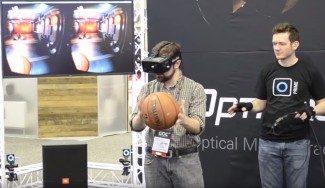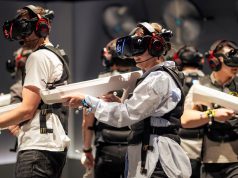Noitom, a leading mo-cap company, are using their affinity with capturing reality by fusing it with virtual reality to create a multi-user mixed reality experience that allows users to interact in VR and others using real world objects. Noitom calls this combination of systems and modalities Project Alice, and they were at SVVR 2016 to show it off. Road to VR’s Executive Editor Ben Lang went hands on.
Project Alice is mashup of several different systems to create a unique VR experience which highlights the power of social VR and mixed reality. The system, which Noitom is positioning as a B2B product priced around $100,000, comprises a high-end optical mocap system combined with Noitom’s own IMU tracking sensors. The company also says they created the backend software which ties these systems together and runs VR experiences on top of them; the result is an immersive multi-user VR experience which allows users to interact with virtual and real objects.
Virtual reality is the most seamless and natural way of connecting with someone else through a computer. Matching real-world props to virtual objects takes this to the next level. As part of the Project Alice experience, we got to see this first hand (see video at the very top of the page). In one scene there were a number of real-life objects that were exactly matched to their virtual counterparts. That meant that when I saw a virtual stool sitting in front of me and reached out to touch it, it was actually there in real life. When I picked up the stool, it moved correctly in VR, and I was even able to hand it to the person standing next to me. Basically, it felt just like interacting with a stool in the real world, and the closer we can make the virtual world to the real world, the more immersive it becomes.

Mixing real items into a VR environment makes human-to-human interaction in VR even easier and more natural than using a purely virtual modality; if I want to hand you an object, I can simply hand it to you, and you can reach out and know that you will be able to physically grab the object. When I was holding a foam block, for instance, it’ was incredibly easy to rotate and manipulate it, because everyone knows how to rotate and manipulate a foam block in real life.
The exciting part comes when you append digital information onto that block that couldn’t exist in real life (maybe the front has a virtual screen on it showing some important data from the web, while the back has virtual buttons to change what’s displayed on the front). Now instead of sending someone a link with the info I’m seeing, I could literally toss the object containing the info to them. It’s a more human and natural way of communicating from one person to another inside of a computer, and large, multi-user VR systems like these are likely to take real-time collaboration to the next level.









